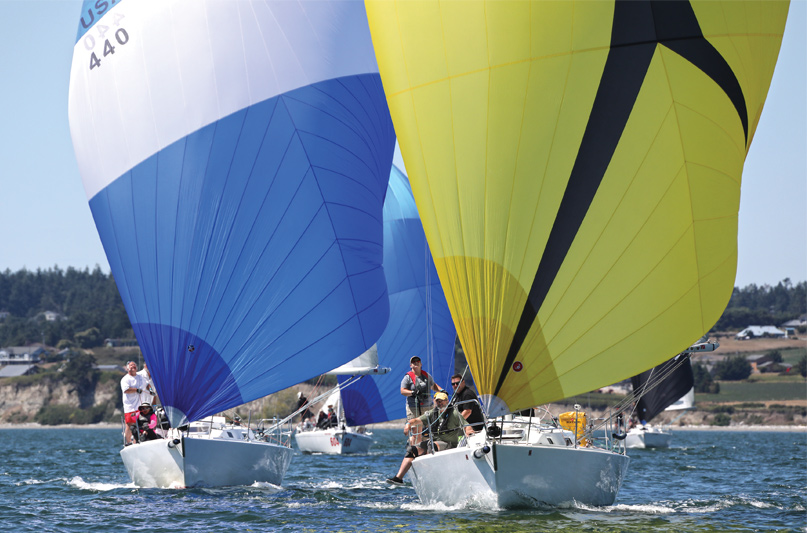
Sailing in the Pacific Northwest is at somewhat of a tipping point with traditional events needing to adapt to the changing times and new events springing up and finding astounding popularity. It is important to look ahead and tackle new adventures, but it’s also important to take time to enjoy a swan song every now and again. This past month I got to take part in both sides of the spectrum, racing with my family in the last Whidbey Island Race Week and our first Northern Century. I can honestly say that both experiences were fantastic.
This year’s Whidbey Island Race Week was a reminder of the fun had over the decades, but also pushing us towards something new. Just like old times, the week featured solid wind and more crabs caught than any one crew could home to eat. It is sure to go down as the quintessential measuring stick of Northwest sailing.
On the water, the J/boats took the trophy for best represented with nearly 30 boats sporting the blue logo on the water every day. The J/105 fleet was out in force with 11 boats on the start line. They did not disappoint at the finish line as the fleet of impeccably competitive boats reminded us all why the fleet is growing every year. Alongside the 105s, the J/80 enjoyed some one design fleet racing with seven boats on the start line, with several races being literally seconds between the first-place boat and a mid-fleet finish. It was definitely a regatta to remember and some happy racers took home hard-fought silverware. Rounding out the race were six handicap fleets stacked with everything from the pure-bred racing machines of Shrek and 65 Red Roses (fresh off their Van Isle 360 overall win) to multigenerational affairs aboard the Hawkens family’s Teddy Bear in the non-flying sails cruising fleet.
Steady winds and sunshine made for superb racing and all fleets got off their full schedule with the racing fleets finishing nine each and the cruising classes racking up four. With the event moving the venue to Point Roberts next year, it was a fitting last hurrah of a long-standing tradition. As the event shifts northward, it is sure to bring some changes as well as new faces, but it will remain a real destination sailing event, the same status that put WIRW on the map to begin with. Personally, I would be shocked if we don’t see boats racing on Penn Cove in years to come, it’s just so great a venue to go to waste.
Toward the end of August, it dawns on some people that many of the highlights of summer are behind us. As our ears finally recover from the Blue Angels and our livers regain composure from the log boom at Sea Fair, there are a few late bloomers of the Pacific Northwest summer left before the cold weather races of fall bring out our KAM fleeces out of the closet. Northern Century began life as a double handed, 100-mile race that kisses the absolute north most part of the continental United States.
The regatta essentially takes the fleet on a self-guided tour of the San Juan Islands. The racecourse is simple: leave Anacortes, sail up to a mark off Point Roberts (yes, the same Point Roberts), work your way south to a mark off Hein Bank, and then sail back to Anacortes. Sounds simple enough, except add in the currents, commercial traffic, summer kelp, and a Friday evening start and things begin to get interesting fast.
This year was the first time that Charlie Macaulay and the team onboard the black and yellow Farr39 Absolutely have taken part in this race. The mixed fleet of double handed and fully crewed boats ranging from 24 to 50 feet and had everything from cutting edge carbon fiber sails to canvas topsails flying onboard schooners with wooden masts. With so many different channels and options for taking on the currents and shifting winds, it makes for an excellent challenge and truly pushes skippers and navigators to fight for every inch of ground. Rolling the dice on a narrow channel with the hopes that you make it through before the current changes is the ultimate zero to hero move, but can also bite you if the wind shifts and you miss your window.
A beautiful sunset welcomed sailors and a light shore breeze let most boats get out of the bay with only minor scrambling to change back and forth from the spinnaker to jibe. Once the fleet cleared out of the bay and began running along the shore of Lummi Island, things began to settle down into a smooth southerly wind that carried boats through the night. Unfortunately, not everyone made it to this transition, and several boats of all shapes and sizes were left with hanging sails, watching the stern lights of the front pack disappear into the night. The lead group could stay in contact with the wind, while the trailing fleet got shut down by the current and kelp forcing boats to back down nearly a dozen time to clear their keels.

A pleasantly overcast morning gave way to sunshine the next day. Onboard Absolutely, it was all smiles as we led the fleet into the islands. The wind began to fill in from the south and for a few moments it felt as though we were going to have steady breeze all the way to the finish. That was not the case as things shut down completely around the south end of the islands. We battled into the finish with the drifter up to take the fully crewed win while the Melges 24 Millennial Falcon took the double handed and the overall corrected win in an impressive race. A fitting end to a sail-acious summer.
